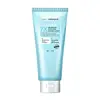What's inside
What's inside
 Key Ingredients
Key Ingredients

 Benefits
Benefits

 Concerns
Concerns

 Ingredients Side-by-side
Ingredients Side-by-side

Water
Skin ConditioningSodium Lauroyl Isethionate
CleansingCocamidopropyl Betaine
CleansingSodium Hyaluronate
HumectantGlycol Distearate
EmollientAcrylates Copolymer
Niacinamide
SmoothingSodium Chloride
MaskingMaltooligosyl Glucoside
Skin ConditioningHydrogenated Starch Hydrolysate
HumectantPEG-120 Methyl Glucose Dioleate
EmulsifyingCeramide As
Skin ConditioningCeramide AP
Skin ConditioningCeramide Ng
Skin ConditioningCeramide Eos
Skin ConditioningCeramide EOP
Skin Conditioning3-O-Ethyl Ascorbic Acid
Skin ConditioningDisodium EDTA
Hydroxyacetophenone
AntioxidantCaprylhydroxamic Acid
Centella Asiatica Leaf Extract
Skin ConditioningCitrus Reticulata Fruit Extract
Skin ProtectingTriethanolamine
BufferingCitrus Medica Limonum Peel Extract
EmollientWater, Sodium Lauroyl Isethionate, Cocamidopropyl Betaine, Sodium Hyaluronate, Glycol Distearate, Acrylates Copolymer, Niacinamide, Sodium Chloride, Maltooligosyl Glucoside, Hydrogenated Starch Hydrolysate, PEG-120 Methyl Glucose Dioleate, Ceramide As, Ceramide AP, Ceramide Ng, Ceramide Eos, Ceramide EOP, 3-O-Ethyl Ascorbic Acid, Disodium EDTA, Hydroxyacetophenone, Caprylhydroxamic Acid, Centella Asiatica Leaf Extract, Citrus Reticulata Fruit Extract, Triethanolamine, Citrus Medica Limonum Peel Extract
Water
Skin ConditioningCocamidopropyl Betaine
CleansingPotassium Cocoyl Glycinate
Arginine
MaskingRosmarinus Officinalis Extract
AntimicrobialAvena Sativa Kernel Extract
AbrasiveTremella Fuciformis Extract
HumectantCeramide Ns
Skin ConditioningCeramide NP
Skin ConditioningCeramide Eos
Skin ConditioningCeramide EOP
Skin ConditioningCeramide As
Skin ConditioningCeramide AP
Skin ConditioningCentella Asiatica Extract
CleansingAloe Barbadensis Extract
Skin ConditioningDatem
EmollientLactobacillus/Rice Ferment
Skin ConditioningSaccharomyces Ferment Lysate Filtrate
Skin ConditioningLactococcus Ferment Lysate
Skin ConditioningDMDM Hydantoin
PreservativeWater, Cocamidopropyl Betaine, Potassium Cocoyl Glycinate, Arginine, Rosmarinus Officinalis Extract, Avena Sativa Kernel Extract, Tremella Fuciformis Extract, Ceramide Ns, Ceramide NP, Ceramide Eos, Ceramide EOP, Ceramide As, Ceramide AP, Centella Asiatica Extract, Aloe Barbadensis Extract, Datem, Lactobacillus/Rice Ferment, Saccharomyces Ferment Lysate Filtrate, Lactococcus Ferment Lysate, DMDM Hydantoin
Ingredients Explained
These ingredients are found in both products.
Ingredients higher up in an ingredient list are typically present in a larger amount.
Ceramide AP is formally known as Ceramide 6.
Ceramides are intercellular lipids naturally found in our skin that bonds dead skin cells together to create a barrier. Having a strong skin barrier leads to more firm and hydrated skin.
They are known for their ability to hold water and thus are a great ingredient for dry skin. By bolstering the skin ceramides act as a barrier against irritating ingredients. This can help with inflammation as well.
If you would like to eat ceramides, sweet potatoes contain a small amount.
Read more about other common types of ceramides here:
Ceramide NP
Ceramide EOP
Ceramide AS is formally known as Ceramides 4 and 5.
Ceramides are intercellular lipids naturally found in our skin that bonds dead skin cells together to create a barrier. They are known for their ability to hold water and thus are a great ingredient for dry skin.
Ceramide EOP is formally known as Ceramide 1 and Ceramide 1 A.
EOP stands for a linked Ester fatty acid, a linked Omega hydroxy fatty acid, and the Phytosphingosine base.
Ceramides are intercellular lipids naturally found in our skin. They bind dead skin cells together to create a barrier. The ceramides in our skin have the ability to hold water to keep our skin hydrated.
Ceramides are an important building block for our skin barrier. A strong skin barrier helps with:
If you would like to eat ceramides, sweet potatoes contain a small amount.
Read more about other common types of ceramides here:
Learn more about Ceramide EOPCeramide EOS is a type of Ceramide.
Ceramides are intercellular lipids naturally found in our skin that bonds dead skin cells together to create a barrier. They are known for their ability to hold water and thus are a great ingredient for dry skin.
Ceramide EOS is a synthetic N-acylated sphingolipid consisting of Sphingosine having the D-erythro structure linked to an esterified omega-hydroxy saturated or unsaturated fatty acid
Learn more about Ceramide EosCocamidopropyl Betaine is a fatty acid created by mixing similar compounds in coconut oil and dimethylaminopropylamine, a compound with two amino groups.
This ingredient is a surfactant and cleanser. It helps gather the dirt, pollutants, and other impurities in your skin to be washed away. It also helps thicken a product and make the texture more creamy.
Being created from coconut oil means Cocamidopropyl Betaine is hydrating for the skin.
While Cocamidopropyl Betaine was believed to be an allergen, a study from 2012 disproved this. It found two compounds in unpure Cocamidopropyl Betaine to be the irritants: aminoamide and 3-dimethylaminopropylamine. High-grade and pure Cocamidopropyl Betaine did not induce allergic reactions during this study.
Learn more about Cocamidopropyl BetaineWater. It's the most common cosmetic ingredient of all. You'll usually see it at the top of ingredient lists, meaning that it makes up the largest part of the product.
So why is it so popular? Water most often acts as a solvent - this means that it helps dissolve other ingredients into the formulation.
You'll also recognize water as that liquid we all need to stay alive. If you see this, drink a glass of water. Stay hydrated!
Learn more about Water